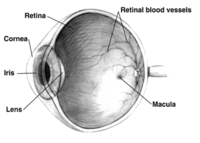
Photo from wikipedia
Fuchs uveitis (FU) is a chronic and often unilateral ocular inflammation and characteristic iris atrophic changes, other than heterochromia, are common in FU and are key to the correct diagnosis… Click to show full abstract
Fuchs uveitis (FU) is a chronic and often unilateral ocular inflammation and characteristic iris atrophic changes, other than heterochromia, are common in FU and are key to the correct diagnosis in many cases. With the advent of anterior segment optical coherence tomography (AS-OCT), some investigators attempted to quantitatively study these atrophic changes; mostly by introducing various methods to measure iris thickness in AS-OCT images. We aimed to present an automated method in an observational case series to measure the smoothness index (SI) of the iris surface in AS-OCT images. The ratio of the length of the straight line connecting the most peripheral and central points of the anterior iris border (in nasal and temporal sides) to the actual length of this border on AS-OCT images, was defined as SI. In a uveitis referral center, twenty-two eyes of 11 patients with unilateral Fuchs uveitis (FU) (7 female) and 22 eyes of 11 healthy control subjects underwent AS-OCT imaging. Image J and a newly developed MATLAB algorithm were used for manual and automated SI measurements, respectively. Agreement between manual and automated measurements was evaluated with Bland–Altman analysis and interclass correlation coefficient. The inter-eye difference of SI was compared between the FU group and the control group. Automated mean overall SI was 0.868 ± 0.037 and 0.840 ± 0.039 in FU and healthy fellow eyes, respectively (estimated mean difference = − 0.028, 95% CI [− 0.038, − 0.018], p < 0.001). Bland- Altman plots showed good agreement between two methods in both healthy and FU eyes. The interclass correlation coefficient between the manual and automated measurements in the FU and healthy fellow eyes was 0.958 and 0.964, respectively. The inter-eye difference of overall SI was 0.029 ± 0.015 and 0.012 ± 0.008 in FU group and control group, respectively (p = 0.01). We concluded that the automated algorithm can rapidly and conveniently measure SI with results comparable to the manual method.
Journal Title: Scientific Reports
Year Published: 2021
Link to full text (if available)
Share on Social Media: Sign Up to like & get
recommendations!